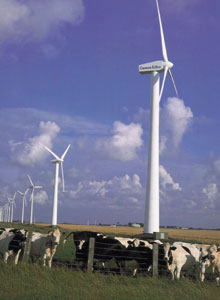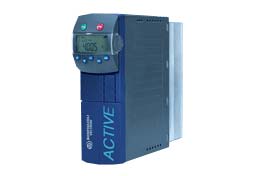 Mini wind turbines vary in size and power, delivering between 5 and 200 kW. They are well-suited for small, mountain or island communities, or small plants running off low voltage lines.
Mini wind turbines vary in size and power, delivering between 5 and 200 kW. They are well-suited for small, mountain or island communities, or small plants running off low voltage lines.
Bonfiglioli Riduttori S.p.A. partners with manufacturers of mini wind plants for weak wind, high turbulence conditions. The company developed electronics for the energy conversion and grid connection system, drawing from experience in regenerative inverter applications. The system receives energy from a sensorless permanent magnet synchronous generator installed in the turbine’s nacelle, and feeds it into the distribution grid. An inverter controlled gearmotor can control turbines with active yaw or pitch control systems.
The turbines usually have a tubular steel mast with a nacelle at the top containing the generator, yaw, and pitch gearmotors, and the rotor the glass fibre blades are attached to. The electronic systems are installed in the electric panel at the foot of the mast.
The regenerative electronic system consists of a two stage IGBT inverter with active bridges at both front ends. A vectron AEC regenerative active front end stage interfaces with the electrical grid, while an ACU vectorial field oriented control stage provides active control of the current from the PMSG in the nacelle.
A sensorless vector control provides open loop control of the PMSG. The angular position is estimated by a special calculus algorithm, which reduces the number of components and wires without any loss of performance from the generator, even at low rotations speeds. The ACU stage of the regenerative system also has to provide four quadrant control of the generator in order to achieve regeneration during normal operation under wind action, and to force motion as required by a test protocol implemented by the wind turbine control program in the PLC to check the mechanical efficiency of the rotor at regular intervals.
While the PLC is transmitting torque reference signals to the ACU Inverter, the ACU is controlling current from the generator and transmitting it to the AEC regenerative stage. (short circuit protections, phase failure, etc).
The system can be equipped with a communication field bus module or digital and analogue input and output interfaces, ensuring immunity from interference and constant monitoring of connection status. The regenerative stage also includes filter components to eliminate conducted EMI and harmonics reflected from the grid, ensuring a constant sine wave current in the phase with grid voltage.
A sensorless vector control system simplifies technology in mini wind plants. The system for the PMSG converts energy without needing an external transducer.
The ACU stage ensures calculation and filtration of the EMF’s harmonic components, starting fromthe generator’s electrical phase quantities, voltage, and current. An automatic alignment function allows the inverter to recognize the reference postition on start-up and store it in memory throughout normal functioning.
The inverter calculates the exact position of the rotor at all times and performs the mathematical transformations needed to control the current vector and cancel the magnetizing component, converting the generator’s mechanical energy into electrical energy. The system is able to transform even small gusts of wind into significant electrical current to feed into the grid. Grid connection efficiency exceeds 95%.
To control risks of dangerous overspeed and variability of the wind, the nacelle and the blades must be able to rotate around their axis to assume the position required by the control system. These rotations, the yaw and pitch, can be achieved by the manufacturer’s Transmital 700 series planetary gearboxes driven by brake motors controlled by inverters that provide vector speed and torque control.
Bonfiglioli
Filed Under: Uncategorized






Whether how big or small these energy producing equipment are as long as they are safe in the environment and will serve its purpose is really all I am going for.